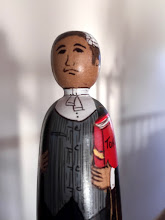The finest barristers’ wigs are
made from the hair of Australian brumbies and Mongolian ponies. I’d like to tell you that wearing one
improves performance, charging one’s submissions with the power and majesty of
those wild beasts. But that would be a lie.
Here is
a short history of wigs and the truth about wearing them. It is the second instalment in a series of three about court dress.
Robes
and wigs have been required attire for English judges since the Judges’ Rules,
a Royal Decree of 1635. Though not subject to the rule, barristers voluntarily
subjected themselves to the code.
While robes were at least warm in English winters, the
wigs were as dangerous and demanding as rabid poodles. Originally made from
human hair, the ‘periwigs’ required regular curling, perfuming and powdering.
Untendered they would become greasy, smelly and dishevelled and were sometimes
infested by nits.
Regular
outings were considered important too. One neglected wig, owned by a struggling
counsel who didn’t get out much, became a nest for rats.
Worse still, because of the plague,
wearers worried that wigs made from the hair of the dead might kill them. Fears
and fumigation eased when master wig maker Humphrey Revenscroft invented a
permanently curled horsehair number. That wig’s descendants have pricked the
heads of lawyers ever since.
Although slow to germinate in our
colonial soils, wig-wearing was firmly rooted in Australia by the 1860s. By
then judges and barristers were suffering heatstroke and law rash in every
courthouse in the land.
Dress-wise, little has changed in our
courts since then. Australian barristers still wear their horsehair court mullets
and man-gowns. We pay thousands of dollars for the privilege. Unfortunately the
price tag doesn’t make them any easier to wear and doesn’t buy dignity.
Though nits and rat nests are rare,
wigs remain a pain to wear. The things are prone to slippage and the old ones
come apart. Curls unspring and fringes dangle. Stray hairs irritate and tickle.
Scratch your head and your rug can be left askew. Turn too quickly and the
mullet tail can catch in your jabot’s Velcro so the whole bloody thing ends up
riding side-saddle. This mishap turns the wearer from learned counsel to drunken
Captain Jack Sparrow in an instant. Little wonder that bewigged barristers
never pace and gesticulate like our American counterparts. Rather we stand
behind our lecterns and move at the speed of a sloth. The fear of wigfall is
real.
Yes. The good old barristers’ wig. It’s
hard to imagine a less practical headdress; unpredictable and unsafe.
To my mind they are at their best not
on one’s head, but perched atop a beautiful wig stand hand-crafted from Huon
Pine and Black Heart Sassafras.




No comments:
Post a Comment